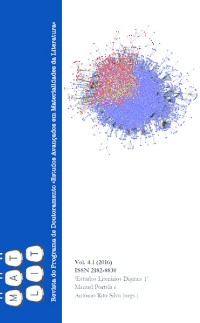Please use this identifier to cite or link to this item:
https://hdl.handle.net/10316.2/38728| Title: | A topographical approach to re-reading books about Islands in digital literary spaces | Authors: | Carpenter, J. R. | Keywords: | ilhas;náufragos;topografia;leitura;texto variável;literatura digital;islands;castaways;topography;reading;variable text;digital literature | Issue Date: | 2016 | Publisher: | Centro de Literatura Portuguesa Imprensa da Universidade de Coimbra |
Abstract: | Este artigo adota uma abordagem topográfica enquanto forma de releitura de livros
impressos em espaços literários digitais através da análise de uma obra de literatura
digital em linha, …and by islands I mean paragraphs (Carpenter 2013). Nesta obra, um
leitor encontra-se à deriva num mar de espaço em branco que se estende além dos
limites da janela do ‘browser’, para norte, sul, leste e oeste. Este mar é pontilhado por
pontos gerados por computador. Estes textos fluidos invocam cadeias de variáveis
que contêm palavras e frases recolhidas de um vasto corpus literário de livros sobre
ilhas. Individualmente, cada uma destas ilhas textuais representa um tópico – a partir
do grego topos, que significa lugar. Coletivamente, constituem um mapa topográfico de
uma prática sustentada de leitura e releitura, de escrita e reescrita sobre o tema das
ilhas. Este artigo argumenta que fragmentos de textos impressos, designados eventosafirmativos
em processos digitais, são reconstituídos como eventos num presente
digital, que é também uma rutura com o presente. Um novo regime de significação
emerge em que a autoria é distribuída e o texto é ‘eventivizado’ (Hayles). Este regime
situa-se na interface entre uma estética incoerente, que tende a desmontar conjuntos
arrumados, incluindo obras conhecidas da literatura impressa; e uma política incoerente,
que tende a dissolver laços institucionais existentes, incluindo ligações de autoria e
de lugar. Galloway denomina este regime de significação de ‘regime sujo da verdade’. This article takes a topographical approach to re-reading print books in digital literary spaces through a discussion of a web-based work of digital literature, …and by islands I mean paragraphs (Carpenter 2013). In this work, a reader is cast adrift in a sea of white space extending far beyond the bounds of the browser window, to the north, south, east and west. This sea is dotted with computer-generated paragraphs. These fluid texts call upon variable strings containing words and phrases collected from a vast literary corpus of books about islands. Individually, each of these textual islands represents a topic—from the Greek topos, meaning place. Collectively they constitute a topographical map of a sustained practice of reading and re-reading and writing and re-writing on the topic of islands. This article argues that, called as statement-events into digital processes, fragments of print texts are reconstituted as events occurring in a digital present which is also a break from the present. A new regime of signification emerges, in which authorship is distributed and text is ‘eventilized’ (Hayles). This regime is situated at the interface between an incoherent aesthetics, one which tends to unravel neat masses, including well-known works of print literature; and an incoherent politics, one which tends to dissolve existing institutional bonds, including bonds of authorship and of place. Galloway terms this regime of signification the ‘dirty regime of truth’. |
URI: | https://hdl.handle.net/10316.2/38728 | ISSN: | 2182-8830 | DOI: | 10.14195/2182-8830_4-1_5 | Rights: | open access |
| Appears in Collections: | Matlit |
Files in This Item:
| File | Description | Size | Format | |
|---|---|---|---|---|
| a_topographical_approach_to_re_reading.pdf | 814.66 kB | Adobe PDF |  |
Items in DSpace are protected by copyright, with all rights reserved, unless otherwise indicated.
